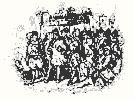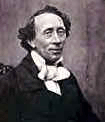Music and Texts of GARY BACHLUND
Vocal Music | Piano | Organ | Chamber Music | Orchestral | Articles and Commentary | Poems and Stories | Miscellany | FAQs
Four Fables
These four one-act chamber operas based on fables by Hans Christian Andersen were conceived as a set, the first two before an intermission and the second two after. Of course, they may be used separately or paired in other ways. The following is a short explanation of the rationale.
A Rationale for Family Opera
Family opera - a coined expression for opera created both for children and adults alike.
In the development of opera audiences, school children are often introduced to opera through young audience programs, bringing them into specifically set aside rehearsals and performances of a small repertoire of opera , such as Hansel und Gretel, for example. Such large productions are costly for producing organizations, and young audience programs are usually sustained by grants from government agencies involved in education. Much in an opera organization's season will exclude children on the simple basis of ticket prices (a very real function of production costs) language, and subject matter.
On other occasions, opera is brought into schools through outreach programs which present truncated opera excerpts with explanations, a sort of lecture-demonstration. Sometimes "children's opera" is offered, that is, works written specifically towards certain age and grade level expectations, with appropriate subject limitations. Works written to these kinds of constraints will not necessarily fit into producing organizations' seasons, and will not necessarily appeal to children and their parents on multiple levels. Moreover, as with the critiques of many curriculum plans, the question of forming a bridge to the next level and higher production standards remains elusive.
And these very necessary programs do not fulfill the above definition of family opera as "created for children and adults alike."
Hans Christian Andersen [ 1 ] said of his storytelling, "...I recount it to the little ones while remembering that father and mother are listening too, and that they must be given a little food for thought." [ cited in P.S. Iversen's Afterword to Andersen's Fairy Tales, New York, Penguin Books, 1966. ]
Hans Christian Andersen
Like Andersen's goal of stories "simple enough for a child to understand, yet with enough between the lines to appeal to adults as well" [ Iversen, p. 367 ], family opera as a distinct genre should seek to appeal to both child and adult.
As opera can be a costly art form, family opera must accept the challenges of reducing production costs by accepting limitations on expensive resources (large orchestras, large casts, involved scenery and costumes, choruses and ballets). For opera to be family entertainment, it must be relatively inexpensive to produce. And, to begin with, Andersen's stories provide a classic literature base from which to create libretti for opera under such limitations.
With the single stipulation that opera requires 'opera-trained' voices, the adaptations of Andersen's fables into libretti answer many of the limitations which outreach and in-theater productions and the inclusion of children into a mainstream opera audience seem to require. These limitations are: small casts, restricted vocal ranges allowing flexibility in casting choices, minimal sets and costumes, few props, and accompaniment by solo piano or, better, small chamber ensemble.
Therefore, several one-act operas are designed, with casts from one to eight singers, featuring concise storytelling, but which operate on several levels, such that children and adults (per Andersen's charge) may find their own values and interests within them.
Prelude to a Fable is an introduction to Andersen's fables, adapted from his story sometimes titled, "The Fable Alludes to You." It is for two voices - a lyric tenor as the Storyteller, and a character tenor portraying the Dog.
The Emperor's New Clothes adapts Andersen's perhaps best known fable. Its cast is two sopranos, mezzo, two tenors, two baritones and bass (or bass/baritone).
The Little Match Girl is taken from the story of the same name. It is a solo opera for lyric soprano. No sets are really required, as it can be accompanied by lighting changes and/or projections only.
A Love Charm is an adaptation of Andersen's "The Talisman," and utilizes the identical cast as The Emperor's New Clothes, such that these two operas can appear on the same program without additional singers being required.
The four one-acts can comprise an entire evening of opera, with high production values, a total cast of eight singers, and a nine-piece chamber ensemble (or larger by adding additional strings), yet at lower cost than other repertoire, due to the limitations of this genre. Individually, or in smaller sets, the one-acts can be used for outreach or as opera workshop curriculum materials with piano accompaniment alone. [ 2 ]
NOTES
[ 1 ] Hans Christian Andersen (1805-1875), is known best a master of the fairy tale genre, whose stories are world famous. He was however also author of plays, novels, poems, travel books, and several autobiographies. Andersen's first book of tales, Eventyr, fortalte for børn (1835; "Tales, Told for Children"), included such stories as "The Tinderbox" and "The Princess and the Pea." Addition of yet more stories made up the first volume of Eventyr (1837); a second volume was completed in 1842, and to these was added Billedbog uden Billeder (1840; A Picture-book Without Pictures). New collections appeared in 1843, 1847, and 1852. His oeuvre was expanded later with Nye eventyr og historier (1858-72l "New Fairy Tales and Stories").
In this era, these fairy tale collections were new in both style and content. Andersen used the idiomatic constructions of spoken language, thereby breaking with literary tradition. Some of his optimistic tales reveal an belief in the triumph of goodness and beauty, while more pessimistic tales end unhappily. One reason for Andersen's great appeal to both children and adults is that he was not afraid of introducing feelings and ideas that were beyond a child's immediate comprehension, yet he remained in touch with the child's perspective.What makes Andersen's tales so compelling is his identification with the less fortunate. A strong autobiographical sense can be seen in his sadder tales, as he perceived himself as an outsider and suffered in many of his closest personal relationships. An anecdote is told of his visit to the Brothers Grimm in Berlin, which was unhappy in that the Grimms showed themselves absolutely unaware of Andersen's fame.
However, the Grimms were essentially collectors and redactors of fairy tales, while Andersen was the more creative inventor of such stories. Bruno Bettelheim writes, "Each fairy tale is a magic mirror which reflects some aspects of our inner world, and of the steps required by our evolution from immaturity to maturity. For those who immerse themselves in what the fairy tale has to communicate, it becomes a deep pool which at first seems to reflect only our own image; but behind it we soon discover the inner turmoils of our soul -- its depth, and ways to gain peace within ourselves and with the world, which is the reward of our struggles." (p. 309 The Uses of Enchantment: the Meaning and Importance of Fairy Tales, Random House, New York, 1976)
Bettelheim states, "We do encourage our children's fantasies; we tell them to paint what they want, or to invent stories. But unfed by our common fantasy heritage, the folk fairy tale, the child cannot invent stories on his own which help cope with life's problems." (p. 121, Ibid)
Bettelheim also states clearly, "The dominant culture wishes to pretend, particularly where children are concerned, that the dark side of man does not exist, and professes a belief in an optimistic meliorism." (p. 8, Ibid.)
A personal anecdote will illustrate this. While at a cocktail party in Westwood, an illustrious guest with a lengthy resume in children's education asked me about some of my work. When I said in most general terms that I was at work on a libretto for a "family" opera about a girl who is physically abused and subsequently dies, she became distressed at the notion that children might see the work. When I added that I hoped children would see my work onstage, she was even more distressed, commenting that children should be "protected" from such stage works. When I mentioned that the libretto was being drawn from the fable by Hans Christian Andersen entitled "The Little Match Girl," she was even more distressed, as her stance and opinion so easily offered in general and condescending terms was in specific terms easily shown to be a part of what Bettelheim calls the "dominant culture," and therefore, according to Bettelheim, both a pretense and an incorrect belief. So it was; so it is. Our cocktail conversation was terminated as she fled from her own outspoken assertion that children should be "protected" from a simple fable of the famed Hans Christian Andersen. Oddly, this woman's husband was a psychiatrist, for whom the "dark side of man" most certainly does exist. My contemporary tale illustrates most clearly why fables must remain a necessary part of culture, for within them truths may be told -- truths from which a dominant culture often shrinks for the wrong reasons.
[ 2 ] These Four Fables were debuted at Pasadena City College in California, by the students of its opera workshop, under the leadership and fine direction of Anne Marie Ketchum. The premieres were musically prepared by Ted Crain and conducted by Ray Burkhardt. I thank them and the students heartily for that.




